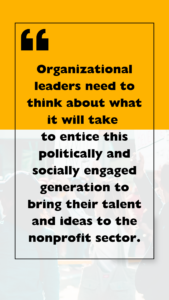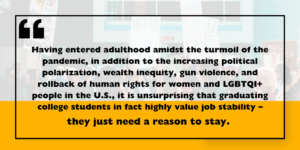Now Is Time to Get Gen Z in the Nonprofit Sector: What We Can Gain from Private Sector Layoffs
If you’ve been on LinkedIn at all this year, chances are that you’ve seen occasional, if not frequent, posts from people sharing the bad news that they’ve been laid off from a job in the tech sector. Over 700 tech companies have laid off employees since the start of 2023, and in an industry once regarded as a beacon of innovation and positive change, the ongoing waves of layoffs have garnered special attention. These layoffs come amid concerns about decreasing gender and racial equity in the sector, poor standards for workers’ rights, and large-scale financial fraud (as seen with FTX) or outright collapse (in the case of Silicon Valley Bank). But while all these factors have dampened the tech industry’s formerly luminous glow, financial, health care, and retail companies have also made sizable reductions in workers this year, and the threat of additional layoffs across the private sector has been looming. Young people entering the workforce are taking notice.
In a recent report on graduating college students, the job search platform Handshake found that 50% of students surveyed feel that news about the economy is impacting their outlook on their future careers. The visibility of tech sector layoffs, in particular, was named as a worrying sign for the class of 2023. However, Handshake’s report also found that, given ongoing economic and industry uncertainty, 44% of graduating seniors plan to apply to more jobs than they would have otherwise, and 35% are open to a wider range of industries than they would have previously considered.
 At the same time, Gen Z – defined loosely as people born between the late 1990s and early 2010s – is proving to be particularly interested in supporting social change. The 2022 U.S. midterm elections received the second-highest youth turnout in nearly 30 years from voters aged 18-29. When it comes to financially supporting causes, GoFundMe’s COO Soraya Alexander told Forbes that younger generations “are willing to cut back [spending] in other areas to continue their charitable giving…[and] they are also more likely than older donors to account for charitable donations in their financial planning.” And while their trust in American institutions has fallen, “62% of Gen Zers agree they have the potential to impact the world,” and 78% took at least one action related to the political and social protest movements in 2020. Gen Z is predicted to account for 27% of the workforce in OECD countries by 2025, which means that many of them are preparing to enter the job market for the first time. Organizational leaders need to think about what it will take to entice this politically and socially engaged generation to bring their talent and ideas to the nonprofit sector.
At the same time, Gen Z – defined loosely as people born between the late 1990s and early 2010s – is proving to be particularly interested in supporting social change. The 2022 U.S. midterm elections received the second-highest youth turnout in nearly 30 years from voters aged 18-29. When it comes to financially supporting causes, GoFundMe’s COO Soraya Alexander told Forbes that younger generations “are willing to cut back [spending] in other areas to continue their charitable giving…[and] they are also more likely than older donors to account for charitable donations in their financial planning.” And while their trust in American institutions has fallen, “62% of Gen Zers agree they have the potential to impact the world,” and 78% took at least one action related to the political and social protest movements in 2020. Gen Z is predicted to account for 27% of the workforce in OECD countries by 2025, which means that many of them are preparing to enter the job market for the first time. Organizational leaders need to think about what it will take to entice this politically and socially engaged generation to bring their talent and ideas to the nonprofit sector.
Voluntary turnover in nonprofits is about 7% higher than the overall workforce average, and younger generations show higher rates of turnover than their older colleagues, an indication that job hopping is seen as a better way to find good pay, work-life balance, and professional development than staying put. Polling by Gallup in 2022 also shows that in the workplace, Gen Z feels higher levels of stress and burnout alongside slightly lower levels of engagement. These feelings are influenced, in no small part, by having their entire professional experiences shaped by the pandemic and the historic workplace disruption that has resulted from it.
Meanwhile, there seems to be an endless supply of articles deriding Gen Z as lazy, entitled, or too difficult to work with. There are many takes on why stereotyping any age group is unhelpful and counterproductive – and as someone who is categorized as a Millennial, it wasn’t so long ago that my generation was the most frequent target for derision. But one thing I know is that those seemingly harmless takes on generational divides don’t make you feel particularly welcomed into a new workplace.

At a time when industries once seen as a professional dream are experiencing public turmoil and backlash, nonprofits have an opportunity to welcome a new generation of people into a mission-driven career path. That means being ready to embrace the different ideas and perspectives that young people inevitably bring to the workplace, as well as reevaluating the practices and norms that have driven high turnover in the nonprofit sector. Having entered adulthood amidst the turmoil of the pandemic, in addition to the increasing political polarization, wealth inequity, gun violence, and rollback of human rights for women and LGBTQI+ people in the U.S., it is unsurprising that graduating college students in fact highly value job stability – they just need a reason to stay. If nonprofit leaders prioritize attracting and retaining younger generations at this moment, they will be taking a critical, yet undervalued step toward ensuring sustainability for the future of the sector.


Comment section
4 thoughts on “Now Is Time to Get Gen Z in the Nonprofit Sector: What We Can Gain from Private Sector Layoffs”